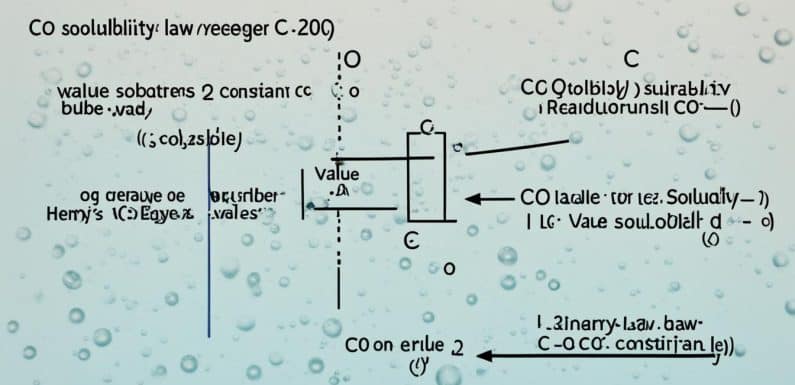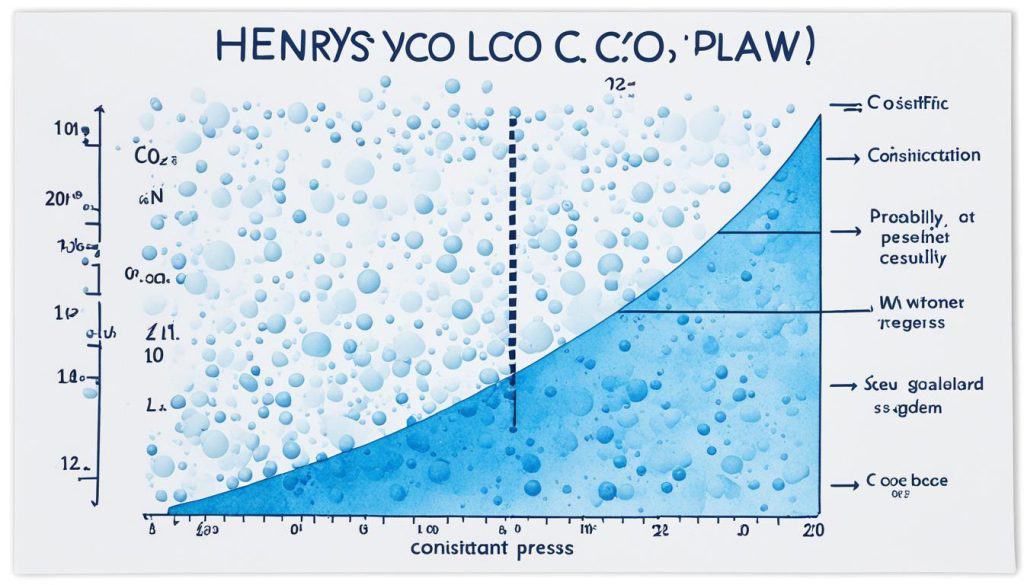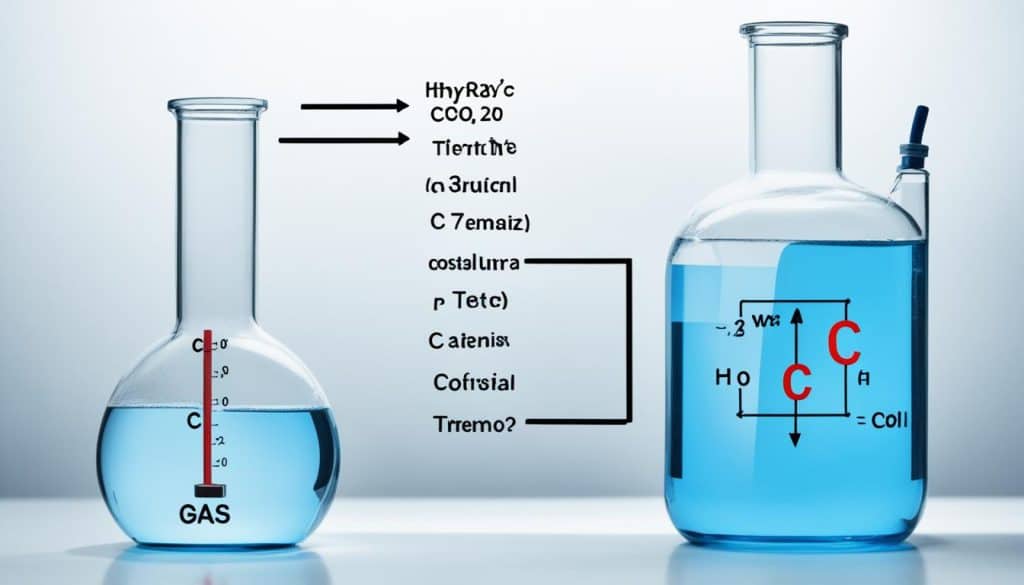
The Henry’s Law Constant for CO2 at 20°C is an essential parameter in the study of gas solubility, particularly for carbon dioxide in various liquids. This constant represents the equilibrium ratio of the concentration of dissolved CO2 to its partial pressure above the solution. The quantified value of Henry’s Law Constant for CO2 at this temperature is crucial for scientists and industries, especially when optimizing production processes and ensuring product quality.
Key Takeaways
- Henry’s Law Constant provides a relationship between gas concentration and partial pressure.
- The value of Henry’s Law Constant for CO2 at 20°C is integral for determining CO2 solubility.
- Understanding this constant is vital for applications such as the beverage industry, influencing carbonation levels.
- Accurate knowledge of the constant helps in the precise control of CO2 in various chemical and industrial processes.
- Henry’s Law Constant is influenced by temperature and pressure conditions.
Defining Henry’s Law Constant in Relation to CO2 Solubility
The Henry’s Law Constant is an essential factor in understanding CO2 solubility in various liquids. This constant provides critical insights into how gases behave when they come into contact with liquids and is particularly important when considering how CO2 dissolves in beverages or other aqueous solutions. In simple terms, it represents the equilibrium condition where the amount of gas entering a liquid matches the amount leaving it.
When we discuss gas solubility, it’s vital to note that it isn’t a fixed value but rather depends on temperature and pressure. The Henry’s Law Constant is instrumental in predicting how much CO2 will be present in a liquid under specific conditions. It also implies that at higher pressures, more CO2 can dissolve in a liquid before reaching equilibrium.
According to the equation C = K * P, with C denoting the concentration of dissolved gas, K representing the Henry’s Law Constant, and P the partial pressure of the gas phase, we can deduce the amount of CO2 that will be soluble in a liquid medium. For industries dealing with carbonated products or environmental scientists studying aquatic ecosystems, mastering the implications of this law is paramount.
While “Not Applicable” might be a placeholder term in certain contexts, in the realm of CO2 solubility and Henry’s Law Constant, there is no room for vagueness. Every data point contributes to a clearer understanding of the dynamic between CO2 and its environment, thereby enabling better control over the carbonation process or the assessment of atmospheric CO2 effects on bodies of water.
| Temperature (°C) | Henry’s Law Constant (atm/(mol/L)) | CO2 Solubility (mol/L) |
|---|---|---|
| 0 | 3.4 | 0.034 |
| 20 | 3.0 | 0.030 |
| 40 | 2.6 | 0.026 |
As illustrated in the data above, Henry’s Law Constant and CO2 solubility change with temperature, indicating that colder liquids can hold more CO2 under the same pressure. This principle is crucial for several applications, from crafting the perfect soda to modeling planet-wide carbon cycles.
What is the Henry’s Law Constant for CO2 at 20 ∘C?
Understanding the Henry’s Law Constant for CO2 at 20°C is pivotal for industries that manage the solubility of gases in liquids, notably CO2’s application in carbonation processes. The constant not only influences the beverage sector, but it is also a key component in understanding environmental impacts where gas solubility plays a vital role.
Establishing the Numerical Value and Units
The numerical value of the Henry’s Law Constant is affected by the physical properties of the system in which CO2 is dissolving. At a standard temperature of 20°C, the Constant for CO2 has an often referred to value of 3.0×10−2 mol L−1atm−1. This numerical value represents the concentration of CO2 that will dissolve in a liter of solvent when the partial pressure of CO2 is at one atmosphere.
Implications of the Constant on Gas and Beverage Industries
The Henry’s Law Constant for CO2, particularly at 20°C, significantly impacts the beverage industry which relies extensively on carbonation. It determines the extent to which CO2 can be dissolved in beverages under given conditions, crucial for the desired fizz in carbonated drinks. In turn, understanding these dynamics informs quality control and product consistency for industry leaders.

In the table below, a comparison of the Henry’s Law Constant values at 20°C is shown for different pressures. Such information is valuable for the gas solubility considerations in various industry applications.
| Pressure (atm) | Henry’s Law Constant (mol L-1atm-1) | Implications for Beverage Carbonation |
|---|---|---|
| 1 | 3.0×10−2 | Standard carbonation level for soft drinks |
| 2 | 3.0×10−2 | Increased carbonation for a stronger fizz |
| 0.5 | 3.0×10−2 | Light carbonation for subtle effervescence |
As displayed, the Henry’s Law Constant serves as a guide to manage CO2 levels, crucial in formulating the taste and texture of carbonated beverages. Understanding this constant at 20°C enables fine-tuning carbonation levels to cater to different consumer preferences and assures the consistency necessary for brand reliability in the market.
Calculating Gaseous Concentrations Using Henry’s Law
Understanding the precise calculation of gaseous concentrations in various environments is imperative for chemists and industry professionals. Utilizing Henry’s Law, a key principle in gas solubility, these calculations become streamlined and accurate. This law provides a direct relationship between the partial pressure of the gas and its dissolved concentration in a liquid. For practical applications, when the partial pressure of a gas such as CO2 is known, one can swiftly determine its concentration in a liquid by dividing it by the Henry’s Law Constant.

The process of calculation plays a crucial role in industries that rely on precise gaseous concentrations, impacting product quality and safety. By applying the formula derived from Henry’s Law, it becomes straightforward to determine the amount of gas that will remain dissolved under set conditions, a factor that is Not Applicable when dealing with solids or non-gaseous substances.
To illustrate the calculation process, let us consider a scenario where the partial pressure of CO2 in the atmosphere above a beverage is known. The Henry’s Law Constant relevant to the beverage at a given temperature is also available. One can calculate the concentration of CO2 in the beverage by dividing the pressure by the constant, as follows:
| Known Partial Pressure of CO2 (atm) | Henry’s Law Constant for CO2 at 20°C (mol/L*atm) | Calculated CO2 Concentration (mol/L) |
|---|---|---|
| 0.5 | 3.0×10−2 | 0.5 / 3.0×10−2 |
| 1.0 | 3.0×10−2 | 1.0 / 3.0×10−2 |
Carrying out such a calculation equips specialists with the knowledge to adjust processes, ensuring optimal levels of gas solubility whether in product manufacturing, environmental monitoring, or countless other applications where gaseous concentrations directly influence outcomes.
Through the precise application of Henry’s Law, the calculation of gaseous concentrations has become a reliable and fundamental aspect of chemical analysis and industrial operations.
Temperature’s Impact on the CO2 Henry’s Law Constant
The interplay between temperature and the Henry’s Law Constant for CO2 is a pivotal aspect of gas solubility in liquids. When evaluating the temperature’s impact, it’s clear that even slight fluctuations can lead to marked changes in how CO2 behaves. As industry professionals and environmental scientists can attest, this temperature sensitivity is more than a mere data point; it’s a significant consideration in the design and management of systems where gas-liquid interactions are critical.
Specifically, an upward shift in temperature tends to cause a reduction in the Henry’s Law Constant for CO2. This inverse relationship signifies a lower solubility for CO2 in liquids at elevated temperatures, prompting a greater release of the gas into the atmosphere. Such an effect becomes readily apparent when examining carbonated beverages, which rely on precise CO2 solubility levels for their fizz and taste. Equally important, the environmental impact of this temperature-dependent dynamic cannot be underestimated, especially with regard to the earth’s oceans and climate change scenarios.
In summary, acknowledging the temperature’s impact on the Henry’s Law Constant for CO2 is crucial for a broad spectrum of applications, from industrial carbonation processes to environmental conservation efforts. Understanding and anticipating how changes in temperature affect CO2 solubility help in proactively adjusting procedures and policies to maintain the delicate balance of ecosystems and product quality alike.
FAQ
What is the Henry’s Law Constant for CO2 at 20 ∘C?
What is the relationship between the Henry’s Law Constant and CO2 solubility?
How can the Henry’s Law Constant be used to calculate gas concentrations in a liquid?
Does the Henry’s Law Constant for CO2 change with temperature?
Source Links
- https://www.toppr.com/ask/question/henrys-law-constant-k-ofco2-in-water-at20circc-is-30times-102moll1atm1-calculate-the-mass-of/
- https://www.studocu.com/en-ca/messages/question/4183421/henrys-law-constant-for-co2-at-20c-is-00376-mol-l1-bar1-at-101-bar-at-250-degrees-c-henrys
- https://www.pearson.com/channels/general-chemistry/asset/459d39ee/the-henry-s-law-constant-for-co2-in-water-at-25-c-is-3-1×10-2-m-atm-1-a-what-is-
